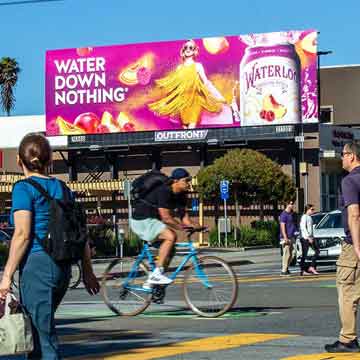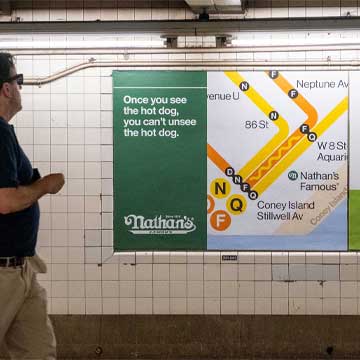
Purchasing the Zeitgeist – Why IRL Out of Home Advertising Is a Real Friend to AI Startups
November 20, 2025
Let’s get something out of the way: we do not condone the vandalism of our media. Please don’t do it.
That being said…
You may have heard about how AI wearable startup Friend blanketed the New York City MTA’s Subway system with $1 million worth of traditional-format ads for its flagship product, only for infuriated New Yorkers to engage with the campaign by defacing it with Sharpies.
An AI startup monetizing our loneliness touched a nerve, perhaps not unexpectedly. Artificial Intelligence is a hot button issue these days, and social isolation hangs over us like a cloud. “Loneliness and emotional disconnection appear to have become a defining feature of life in America,” the American Psychological Association said in introducing a series of somber statistics: 54% of U.S. adults say they feel isolated from others. 50% feel left out. 50% feel that they lack companionship. The APA called it a “crisis of connection.”
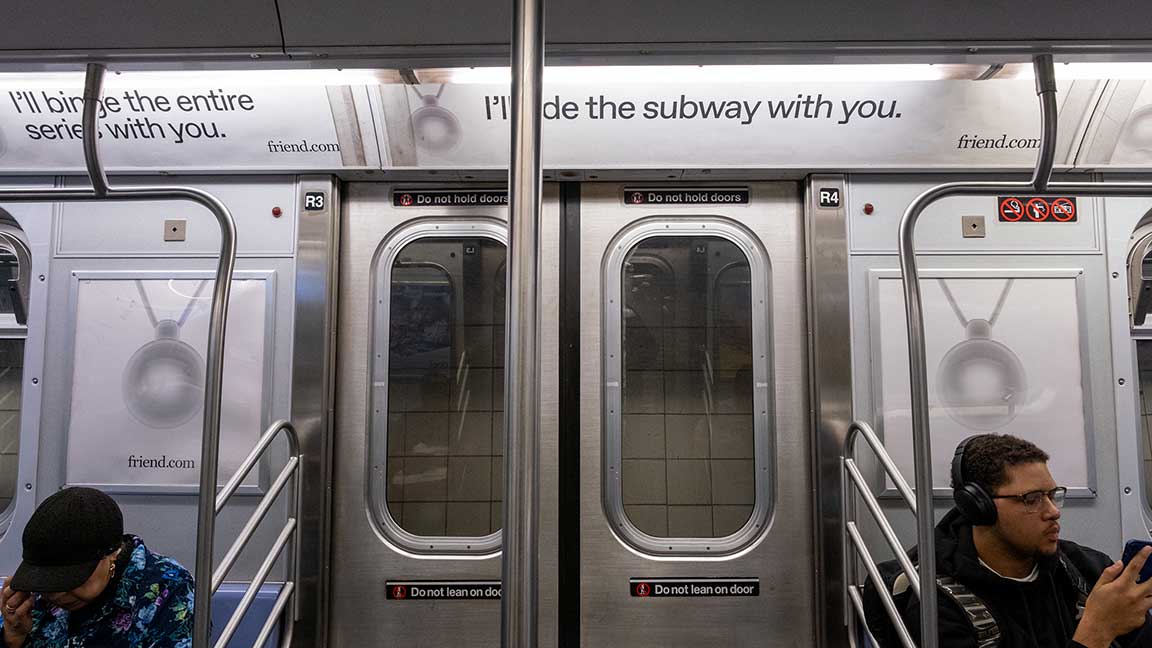
Of course, where some see crisis – others see opportunity. Enter Avi Schiffman, the 22-year-old founder of Friend. Its product, a $129 microphone-enabled pendant that texts its wearer ongoing commentary on what it hears, had been selling a modest 400 units per week since launching in July (SOURCE: ADWEEK). Central to its go-to-market plan was this massive two-month subway advertising campaign that included 11,000 car cards, over 1,000 platform posters, 130 urban panels, and a Station Domination at West 4th Street. The ad buy also included a blitz of bulletins, bus media, and shelters in Los Angeles. Traditional static media are often preferred by digital-first startups because IRL advertising offers otherwise intangible brands a real-world physical presence.
The ads, designed by Avi himself, were mostly white space, with plain black text taglines like “I’ll never leave dirty dishes in the sink” and “I’ll never bail on our dinner plans.”
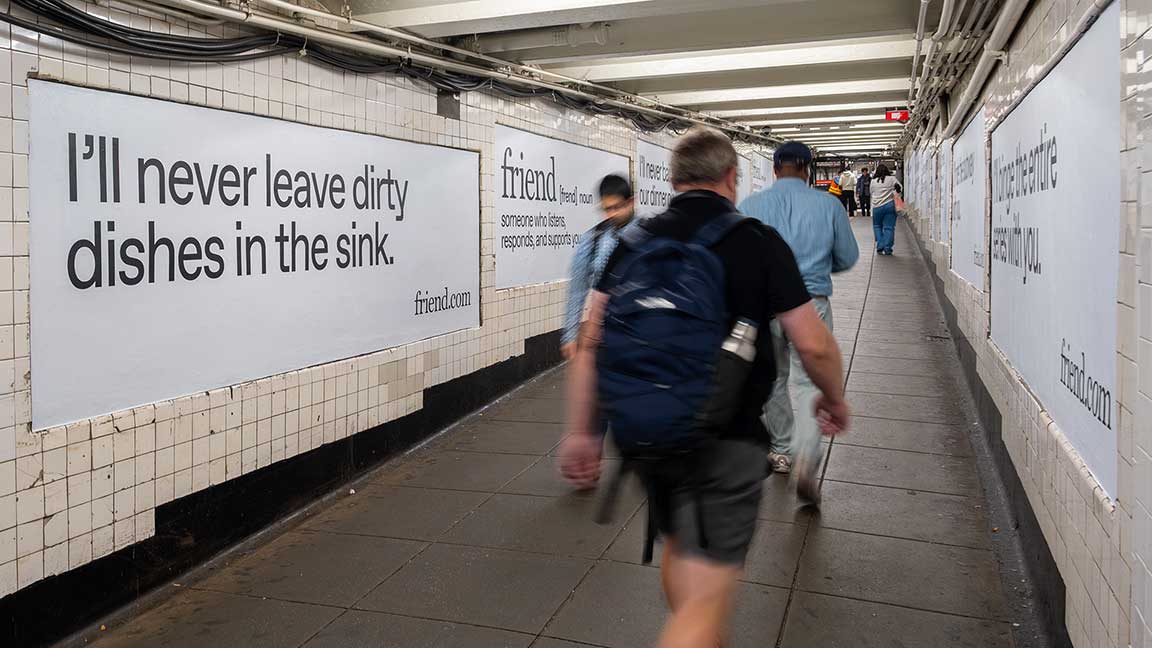
To say these anodyne messages rubbed their audience the wrong way would be an understatement.
“AI would not care if you lived or died,” somebody angrily wrote on one poster. “Go make real friends,” scribbled another in red, “this is SURVEILLANCE!” Dozens of the ads were tagged across the five boroughs.
Looks like the Friend AI campaign isn’t going that well. pic.twitter.com/RNKnDbQKxn
— VonDoom ☕️ (@CryptoVonDoom) September 28, 2025
You’d think that Avi would have been upset – or taken aback by the emotional response – but you’d be wrong. In fact, he seemed to relish playing the heel. “I know people in New York hate AI, and things like AI companionship and wearables, probably more than anyone else in the country,” he told ADWEEK. “So I bought more ads than anyone has ever done with a lot of white space so that they would socially comment on the topic.” He called the response from the public “artistically validating.”
Maybe there really is no such thing as negative attention. Sure, everyone hated the ad campaign – but everyone saw it – and everyone was talking about it. The New York Times, New York Post, TechCrunch, Gothamist, Business Insider, Fortune, The Atlantic, Politico, and The Nation all covered the campaign – some more than once. A single Reddit post on the Friend ad campaign earned over 104,000 upvotes and 3,500 comments.
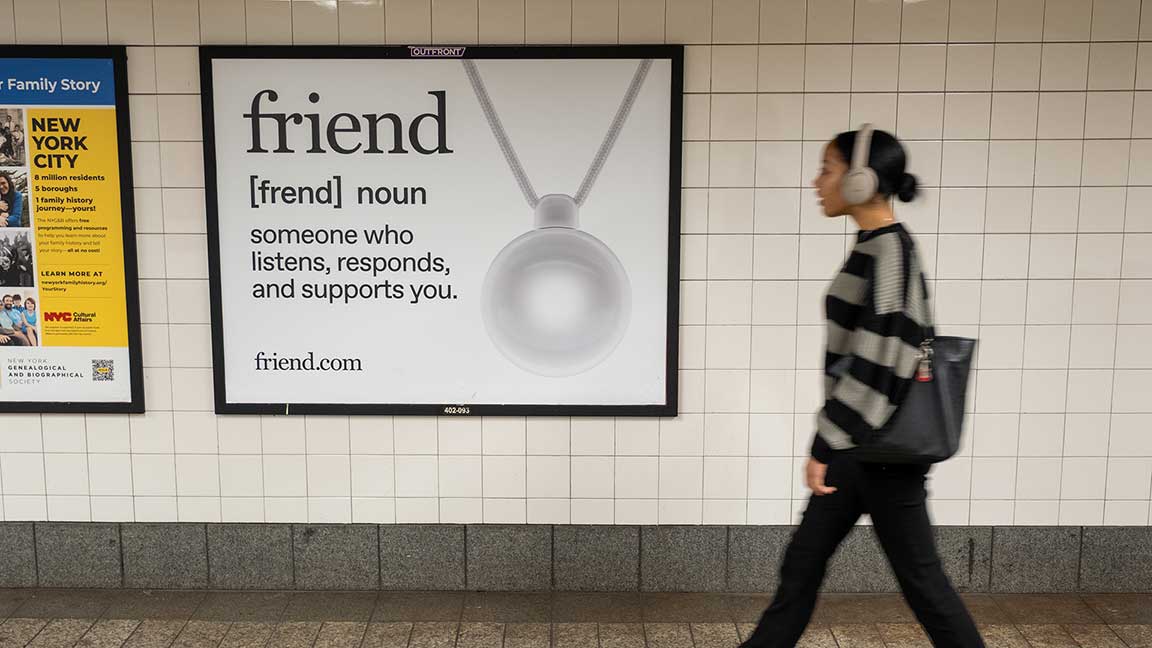
This was one of those times when an ad campaign is so influential that it crosses over from commerce to become culture. Perhaps the exact moment when it crossed over was when other brands began wading into the discourse.
Soon after Friend’s campaign launch went viral, Heineken ran a digital billboard campaign with the tagline “The best way to make a friend is over a beer,” with a bottle opener on a lanyard bearing an uncanny resemblance to the device.
The campaign even inspired at least one costume. “I hate NYC Halloween,” read the TikTok caption, “cause what do you mean you’re the friend.com AI subway ad and you let people graffiti you.” The video got 113,000 likes and nearly 7,000 shares.
@joshjoshjosh.net Works best with irl friends #halloweencostume #nyc ♬ original sound - joshjoshjosh.net
Avi saw the costume. His response? “Probably the best $1m I’ll ever spend.”
But now it’s November. Halloween costumes don’t keep the lights on. Did the campaign’s impact extend beyond mere buzz?
Turns out it did. According to Avi, all that earned media over the first week of the campaign propelled Friend over the 200,000-user mark (SOURCE: Gizmodo). So, joke’s on us. We all took the bait. The Batman gambit worked. “I purchased the zeitgeist,” he told Fortune.
Or, as one X user put it, “the dystopian nihilistic resentment we have for the tech is a fundamental piece of the marketing strategy.”
In San Francisco, Artisan is another AI brand that deliberately courted provocation to make its billboards go viral. Seeing the “Hire Artisans, Not Humans” tagline as a warning for the future, those wary of the technology shared images of the billboards far and wide, painting the campaign as emblematic of the industry – not a bad position for a brand to be in, even if put there by its haters.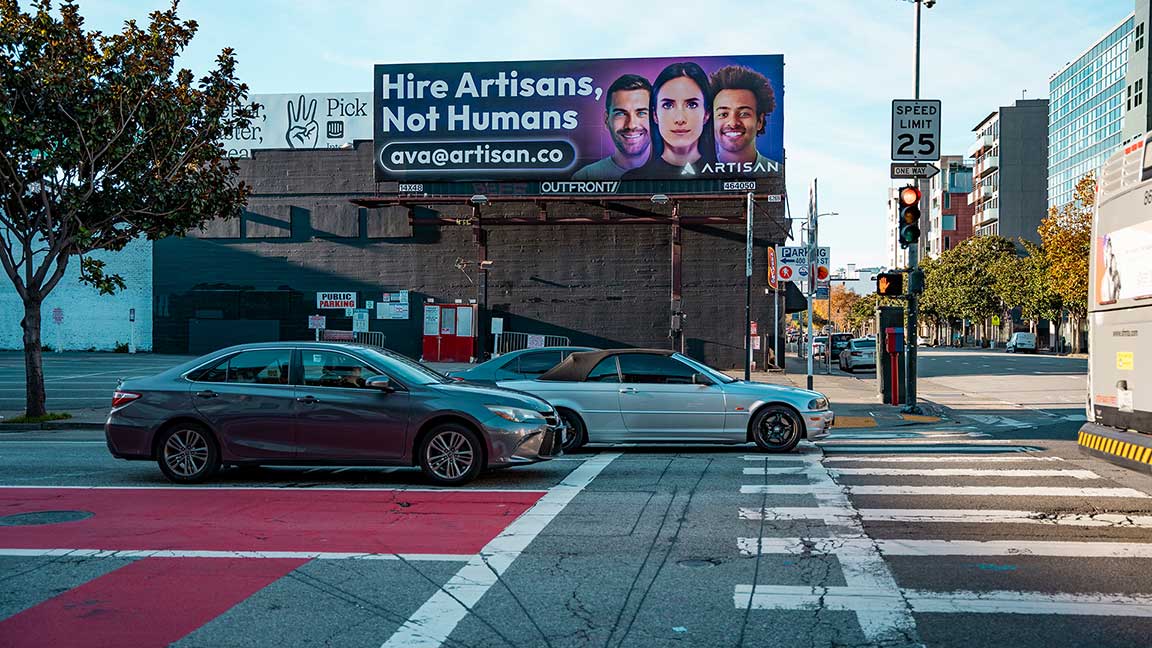
Right now, there are more than 62,000 artificial intelligence startups in the United States, so one way or another, these brands need to stand out (SOURCE: StartUs Insights). Fortunately, the visceral rage button isn’t the only one they’re pushing to do so.
Take Cluely, for example, whose summertime campaign was called “Times Square’s strangest billboard” and “the anti-ad flex.” Spanning the many faces of the Times Square Tower (the last remaining static spectacular in the square), the ad shared the stark black-and-white aesthetic of the Friend ads, but with a self-deprecating, brutally honest message over three lines of plain text: “hi i’m roy im 21 / this was very expensive / pls buy my thing,” followed by the URL.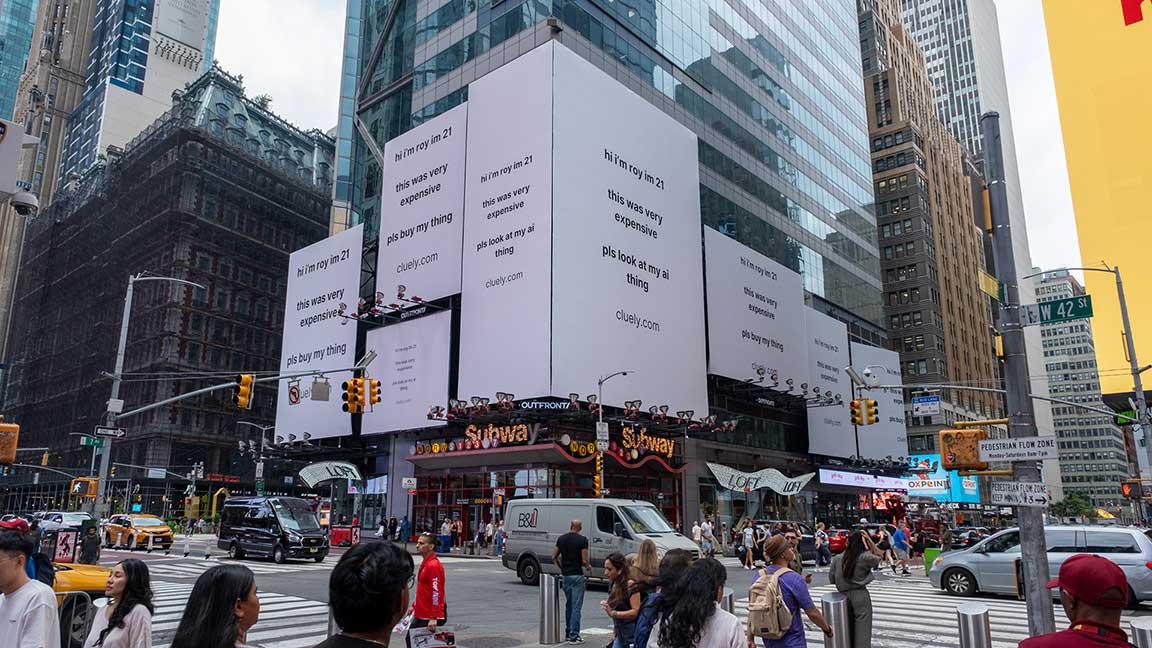
For founder Roy Lee, it was a trust play. “The world has grown tired of corporate marketing and values, more than anything, transparency and to know people more than companies,” he said. “We thought this hyper simple, hyper casual messaging that starts with my name and age was the best way to showcase this.” The result? A 4x improvement in web traffic (SOURCE: Yahoo Finance).
For AI startups, building trust is not a “nice to have” – it is absolutely essential. And much work remains to be done. Only 41% of Americans are willing to trust AI, 45% believe the risks outweigh the benefits, and 75% are concerned about its negative outcomes. Four in ten say they’ve personally experienced or observed a negative outcome, the most common of which is inaccuracy, which has been so pervasive and jarring that it’s become fodder for memes (SOURCE: KPMG).
From coast to coast, AI brands establish trust by leaning into IRL advertising to ground themselves in real life, leveraging the real-world physical presence of billboards and transit media to communicate legitimacy while building name recognition and brand trust. Silicon Valley, unsurprisingly, has been the epicenter of the phenomenon. Business Insider even called the Bay Area billboard scene “San Francisco’s most competitive real estate.”
But the IRL ad placement that AI brands in San Francisco really fight for is the Caltrain station at 4th and King, the primary transit link to Silicon Valley. Startups like Together.ai frequently utilize the bright, spacious building to deploy Station Dominations, memorably immersive brand experiences that surround commuters with the messaging of a single advertiser everywhere they look.
How do you grow an AI unicorn? It requires presence, attention, and trust-building. IRL advertising delivers all three.
From startups to hyperscalers, artificial intelligence thrives in real life. Get in touch today and let’s get you growing!
Author: Jay Fenster, Marketing Manager @ OUTFRONT
Links to third-party content are not endorsed by OUTFRONT Media. Past performance may not be indicative of future results. OUTFRONT does not guarantee specific results or outcomes.

